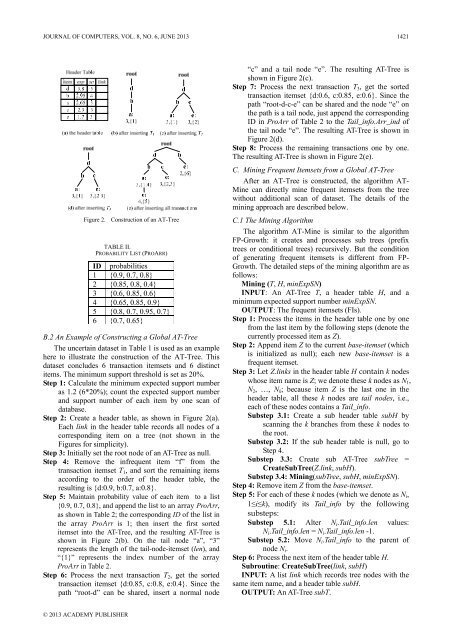Download Full Issue in PDF - Academy Publisher
Download Full Issue in PDF - Academy Publisher
Download Full Issue in PDF - Academy Publisher
Create successful ePaper yourself
Turn your PDF publications into a flip-book with our unique Google optimized e-Paper software.
JOURNAL OF COMPUTERS, VOL. 8, NO. 6, JUNE 2013 1421<br />
Figure 2. Construction of an AT-Tree<br />
TABLE II.<br />
PROBABILITY LIST (PROARR)<br />
ID probabilities<br />
1 {0.9, 0.7, 0.8}<br />
2 {0.85, 0.8, 0.4}<br />
3 {0.6, 0.85, 0.6}<br />
4 {0.65, 0.85, 0.9}<br />
5 {0.8, 0.7, 0.95, 0.7}<br />
6 {0.7, 0.65}<br />
B.2 An Example of Construct<strong>in</strong>g a Global AT-Tree<br />
The uncerta<strong>in</strong> dataset <strong>in</strong> Table 1 is used as an example<br />
here to illustrate the construction of the AT-Tree. This<br />
dataset concludes 6 transaction itemsets and 6 dist<strong>in</strong>ct<br />
items. The m<strong>in</strong>imum support threshold is set as 20%.<br />
Step 1: Calculate the m<strong>in</strong>imum expected support number<br />
as 1.2 (6*20%); count the expected support number<br />
and support number of each item by one scan of<br />
database.<br />
Step 2: Create a header table, as shown <strong>in</strong> Figure 2(a).<br />
Each l<strong>in</strong>k <strong>in</strong> the header table records all nodes of a<br />
correspond<strong>in</strong>g item on a tree (not shown <strong>in</strong> the<br />
Figures for simplicity).<br />
Step 3: Initially set the root node of an AT-Tree as null.<br />
Step 4: Remove the <strong>in</strong>frequent item “f” from the<br />
transaction itemset T 1 , and sort the rema<strong>in</strong><strong>in</strong>g items<br />
accord<strong>in</strong>g to the order of the header table, the<br />
result<strong>in</strong>g is {d:0.9, b:0.7, a:0.8}.<br />
Step 5: Ma<strong>in</strong>ta<strong>in</strong> probability value of each item to a list<br />
{0.9, 0.7, 0.8}, and append the list to an array ProArr,<br />
as shown <strong>in</strong> Table 2; the correspond<strong>in</strong>g ID of the list <strong>in</strong><br />
the array ProArr is 1; then <strong>in</strong>sert the first sorted<br />
itemset <strong>in</strong>to the AT-Tree, and the result<strong>in</strong>g AT-Tree is<br />
shown <strong>in</strong> Figure 2(b). On the tail node “a”, “3”<br />
represents the length of the tail-node-itemset (len), and<br />
“{1}” represents the <strong>in</strong>dex number of the array<br />
ProArr <strong>in</strong> Table 2.<br />
Step 6: Process the next transaction T 2 , get the sorted<br />
transaction itemset {d:0.85, c:0.8, e:0.4}. S<strong>in</strong>ce the<br />
path “root-d” can be shared, <strong>in</strong>sert a normal node<br />
“c” and a tail node “e”. The result<strong>in</strong>g AT-Tree is<br />
shown <strong>in</strong> Figure 2(c).<br />
Step 7: Process the next transaction T 3 , get the sorted<br />
transaction itemset {d:0.6, c:0.85, e:0.6}. S<strong>in</strong>ce the<br />
path “root-d-c-e” can be shared and the node “e” on<br />
the path is a tail node, just append the correspond<strong>in</strong>g<br />
ID <strong>in</strong> ProArr of Table 2 to the Tail_<strong>in</strong>fo.Arr_<strong>in</strong>d of<br />
the tail node “e”. The result<strong>in</strong>g AT-Tree is shown <strong>in</strong><br />
Figure 2(d).<br />
Step 8: Process the rema<strong>in</strong><strong>in</strong>g transactions one by one.<br />
The result<strong>in</strong>g AT-Tree is shown <strong>in</strong> Figure 2(e).<br />
C. M<strong>in</strong><strong>in</strong>g Frequent Itemsets from a Global AT-Tree<br />
After an AT-Tree is constructed, the algorithm AT-<br />
M<strong>in</strong>e can directly m<strong>in</strong>e frequent itemsets from the tree<br />
without additional scan of dataset. The details of the<br />
m<strong>in</strong><strong>in</strong>g approach are described below.<br />
C.1 The M<strong>in</strong><strong>in</strong>g Algorithm<br />
The algorithm AT-M<strong>in</strong>e is similar to the algorithm<br />
FP-Growth: it creates and processes sub trees (prefix<br />
trees or conditional trees) recursively. But the condition<br />
of generat<strong>in</strong>g frequent itemsets is different from FP-<br />
Growth. The detailed steps of the m<strong>in</strong><strong>in</strong>g algorithm are as<br />
follows:<br />
M<strong>in</strong><strong>in</strong>g (T, H, m<strong>in</strong>ExpSN)<br />
INPUT: An AT-Tree T, a header table H, and a<br />
m<strong>in</strong>imum expected support number m<strong>in</strong>ExpSN.<br />
OUTPUT: The frequent itemsets (FIs).<br />
Step 1: Process the items <strong>in</strong> the header table one by one<br />
from the last item by the follow<strong>in</strong>g steps (denote the<br />
currently processed item as Z).<br />
Step 2: Append item Z to the current base-itemset (which<br />
is <strong>in</strong>itialized as null); each new base-itemset is a<br />
frequent itemset.<br />
Step 3: Let Z.l<strong>in</strong>ks <strong>in</strong> the header table H conta<strong>in</strong> k nodes<br />
whose item name is Z; we denote these k nodes as N 1 ,<br />
N 2 , …, N k ; because item Z is the last one <strong>in</strong> the<br />
header table, all these k nodes are tail nodes, i.e.,<br />
each of these nodes conta<strong>in</strong>s a Tail_<strong>in</strong>fo.<br />
Substep 3.1: Create a sub header table subH by<br />
scann<strong>in</strong>g the k branches from these k nodes to<br />
the root.<br />
Substep 3.2: If the sub header table is null, go to<br />
Step 4.<br />
Substep 3.3: Create sub AT-Tree subTree =<br />
CreateSubTree(Z.l<strong>in</strong>k, subH).<br />
Substep 3.4: M<strong>in</strong><strong>in</strong>g(subTree, subH, m<strong>in</strong>ExpSN).<br />
Step 4: Remove item Z from the base-itemset.<br />
Step 5: For each of these k nodes (which we denote as N i ,<br />
1≤i≤k), modify its Tail_<strong>in</strong>fo by the follow<strong>in</strong>g<br />
substeps:<br />
Substep 5.1: Alter N i .Tail_<strong>in</strong>fo.len values:<br />
N i .Tail_<strong>in</strong>fo.len = N i .Tail_<strong>in</strong>fo.len -1.<br />
Substep 5.2: Move N i .Tail_<strong>in</strong>fo to the parent of<br />
node N i .<br />
Step 6: Process the next item of the header table H.<br />
Subrout<strong>in</strong>e: CreateSubTree(l<strong>in</strong>k, subH)<br />
INPUT: A list l<strong>in</strong>k which records tree nodes with the<br />
same item name, and a header table subH.<br />
OUTPUT: An AT-Tree subT.<br />
© 2013 ACADEMY PUBLISHER
















